Influencer marketing is becoming a widely used strategy for online promotion. For some time now, it has been a buzzword, and the mainstream media frequently makes use of it. ⚡
However, there are still some people who are confused about what influencer marketing is. 🤔 If this is your case too, then is article is right for you!
What is Influencer Marketing?
Influencer marketing is a marketing strategy that involves partnering with individuals who have a significant following and influence on social media platforms. These individuals, known as influencers, typically have a loyal and engaged audience that trusts their opinions and recommendations. 😎 Here’s a video specially designed to help you understand. 👇
Influence marketing in 2024Brands can leverage influencer marketing by collaborating with these influencers to promote their products or services to their followers. 🎯 This often involves sponsored posts, product reviews, or brand endorsements. The goal of influencer marketing is to increase brand awareness, drive sales, and reach new audiences through the credibility and authority of the influencer.

Ten years ago, influencer marketing was limited to celebrities and a few dedicated bloggers. Now, social media influencers are on the rise and saturating the market. 💥 Though their followers vary in size, these influencers have a lot to offer. 😏 Their close-knit community fosters genuine connections, leading to greater trust and engagement. This is referred to as relationship marketing!
However, collaborating with digital creators and influencers is a nifty process that brands need to navigate. 🧭 And we’re here with a guide to make sense of it all. Read on for tips on crafting an effective influencer marketing strategy, and more.
Influencer Marketing Platform
An influencer marketing platform is a software solution that connects brands with influencers or content creators, facilitating collaborations between the two. The platform typically allows brands to search for influencers based on specific parameters such as location, niche, engagement rate, and audience demographic. 📌
Brands and influencers can then communicate, negotiate and execute campaigns on the platform. 📣 The platform may also include tools for measuring the success of campaigns, managing payments and tracking influencer content. Examples of influencer marketing platforms include AspireIQ, GRIN, Influencer.co, Tribe Dynamics and more… We’ll see a more detailed list later on!
Which Social Media Platforms are better for Influencer Marketing?
Facebook and Instagram are the most popular social media platforms for influencer marketing. ✅ However, the influencer market is evolving. Platforms like TikTok, Snapchat, and Clubhouse cater to “everyday influencers” and content creators who want to feel like a real person.
That’s why it’s best to use the most active platforms and channels that make the most sense for your industry. For example, beauty brands are doing well on Instagram, and video games are doing well on Twitch. 🕹️
Influencer Marketing Strategy: 8 Easy Steps
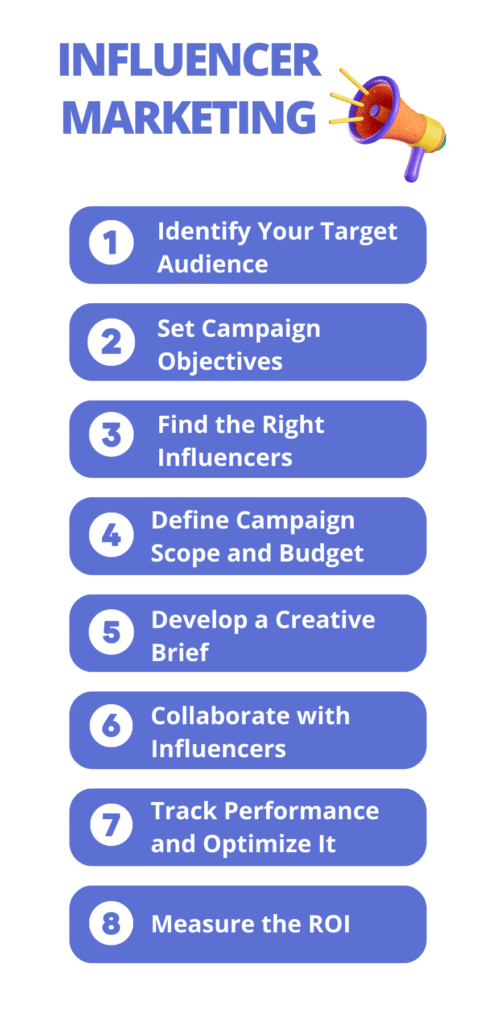
1. Identify Your Target Audience:
The first step in crafting an influencer marketing strategy is to know your target audience. Understand their pain points, interests, and aspirations, and identify the types of influencers they follow. Here are some steps you can follow to do so: 👇
-
Define your product or service: It’s important to have a clear idea of what you’re selling, what it does or solves, and how it can benefit people.
-
Identify the demographics: Demographic can include age, gender, location, income, education level, and job title. Think about who would benefit most from your product or service and what demographic they fall under. 🌎
-
Analyze their behavior: Consider their interests, hobbies, and what motivates them. What are their pain points, and how can your product or service help solve them?
-
Determine their communication preferences: How do they prefer to communicate, and what channels do they use to stay informed? Are they active on social media, read blogs, watch videos, or attend events?
-
Research your competitors: Analyze similar products or services to see who they target and how they communicate with their audience.
-
Create buyer personas: Based on the information you’ve gathered, create a detailed profile of your ideal customer or buyer persona.
-
Test and refine: After identifying your target audience, continue to test and refine your approach. Gather feedback and adjust your strategy as needed to improve engagement and conversion rates. 🧲
2. Set Campaign Objectives:
Once you know your target market, you’ll want to set clear objectives for your influencer campaign. Do you want to increase brand awareness, boost sales, or drive website traffic? 🚗 Make sure to follow these steps:
-
Establish your goals: Define what you want to achieve through your influencer marketing campaign. This could be anything from driving traffic to your website or increasing brand awareness to increasing sales. 💥
-
Define your metrics: Decide how you will measure the success of your campaign. This could include things like engagement rates, click-through rates, or conversions.
- Develop a creative brief: Create a clear brief for your influencers that outlines your campaign objectives, messaging, and any other important information they need to know.
-
Track and analyze results: Monitor the results of your campaign and make adjustments as needed. Continuously track your metrics to measure the success of the campaign and use the insights to inform future campaigns. 📨
3. Find the Right Influencers:
Identify influencers who have the right audience, values, and aesthetics that align with your brand. 🥰 Consider factors such as engagement rates, reach, and authenticity when selecting influencers to work with, you can also:
-
Use Influencer Marketing Platforms: There are various influencer marketing platforms, like Influencer.co, AspireIQ, and Socialbakers, which can help you find the right influencers based on your goals and target audience. These platforms also provide details about influencers’ following, engagement rate, and demographics, making it easier to choose the right one. 🌟
-
Research on Social Media: Conducting research on social media can help you identify influencer in your industry. Analyze hashtags relevant to your brand, check out who is using them and the number of followers they have. Look for popular industry blogs and see which influencers are regularly featured on them.
-
Check Engagement Rates: Engagement is a crucial metric that shows an influencer’s authenticity and has a direct impact on your campaign’s success. Higher engagement rates showcase the ability to connect with the audience, ensuring that your message reaches the maximum number of people.
-
Don’t rely on follower count alone: In recent years, follower count has become a less critical factor when choosing influencers for a campaign. It is essential to look beyond followers and verify if their interests, expertise, and values align with your brand values.
-
Reach out to the influencers: Once you’ve identified the right influencers, reach out to them with a personalized and engaging pitch. Make sure your proposal aligns with their interests and offers further incentives like discount codes or exclusive content. 🤫
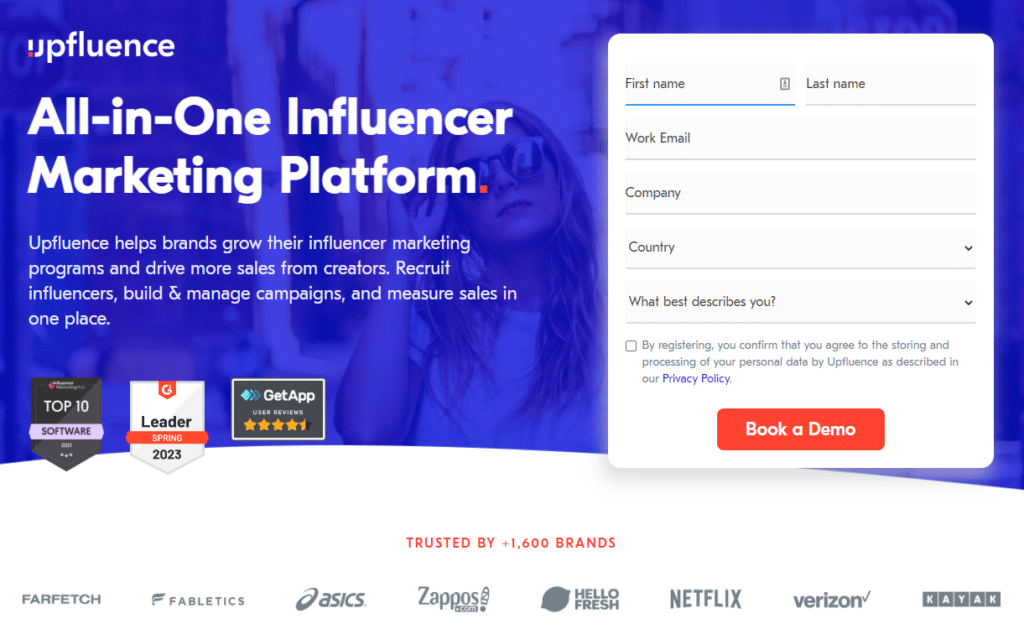
4. Define Campaign Scope and Budget:
Determine the timeline, the number of influencers to be involved, and the budget for the campaign. 💰 Furthermore, here are some tips to establish an influencer campaign scope and budget:
-
Once you have established the target audience, you can begin to identify the influencers you wish to work with. You can use social media listening tools and other relevant resources for this task. Influencers with larger followings tend to cost more, so you need to balance the objective with the budget. 🫰
-
Determine the campaign scope: The scope of the campaign should be determined by the objective and target audience. This may include certain types of content to be created, specific platforms to be used, and the number of influencers to be engaged.
-
Allocate the budget: The budget should be set based on the business objectives and scope of the campaign. This may include fees for influencers, content production costs, and other expenses such as ad spend. 💸
-
Once you have determined the scope and budget for the campaign, you need to review and optimize the plan regularly. This will help you achieve better results and ensure the campaign stays aligned with SMART Goals. ✅
5. Develop a Creative Brief:
Develop a creative brief that outlines the campaign’s goals, messaging, key deliverables, and any creative assets needed. 🌈 Share this with an influencer to ensure they understand your brand and the campaign’s objectives:
-
Establish Your Brand Guidelines: Provide clear brand guidelines to your influencer, including tone of voice, desired messaging, imagery, and any dos and don’ts. Ensure that the influencer is aware of your brand added values, and has an understanding of your target audience. 🎯
- Define Your Key Performance Indicators (KPIs): Establish KPIs that align with your objectives and provide measurable success metrics. This may include metrics such as the number of impressions, engagements, click-throughs, and conversions.
-
Create a Timeline: Establish a timeline for your influencer marketing campaign that outlines key milestones and deadlines. Ensure that the timeline aligns with your budget and KPIs, and allows enough time for influencer research, outreach, content creation, and measurement. 🧐
-
Monitor and Measure Your Results: Regularly track your campaign progress against your KPIs, and make adjustments where necessary. Analyze the results to understand what worked well, what didn’t, and how to improve future campaigns.
6. Collaborate with Influencers:
Cultivate a good working relationship with influencers and provide them with the support they need to create content that resonates with their followers and fits with your brand positioning. 🤝
-
Identify Influencers: The first step in collaborating with influencers is to identify the right ones. Look for influencers whose niche, values, and audience align with your brand’s goals and values. 😍
-
Reach out to them: Once you identify the influencers, reach out to them using a personal and customized approach. Avoid sending generic messages, and instead tailor your outreach to their specific interests and style.
-
Offer Value: Offer something of value in exchange for their collaboration, whether it is a product or service or special promotion. You could also give them exclusive access to your new products, events, or information. 👁️🗨️
-
Set Expectations: Clearly outline your goals and expectations for the collaboration with your influencers. Specify the type of content they are expected to create, the timeline, and the compensation.
-
Monitor the Results: Monitor the results of the collaboration and track the influencer’s reach, engagement, and ROI. This will help you determine if the collaboration was successful and if you should continue working with them in the future. 🔮
-
Maintain Relationships: Maintain good relationships with your influencers, even after the collaboration ends. It’s important to keep them engaged and updated on your brand’s activities and upcoming events. Building long-term relationships with your influencers can help you establish a loyal customer base and increase your brand’s reach.
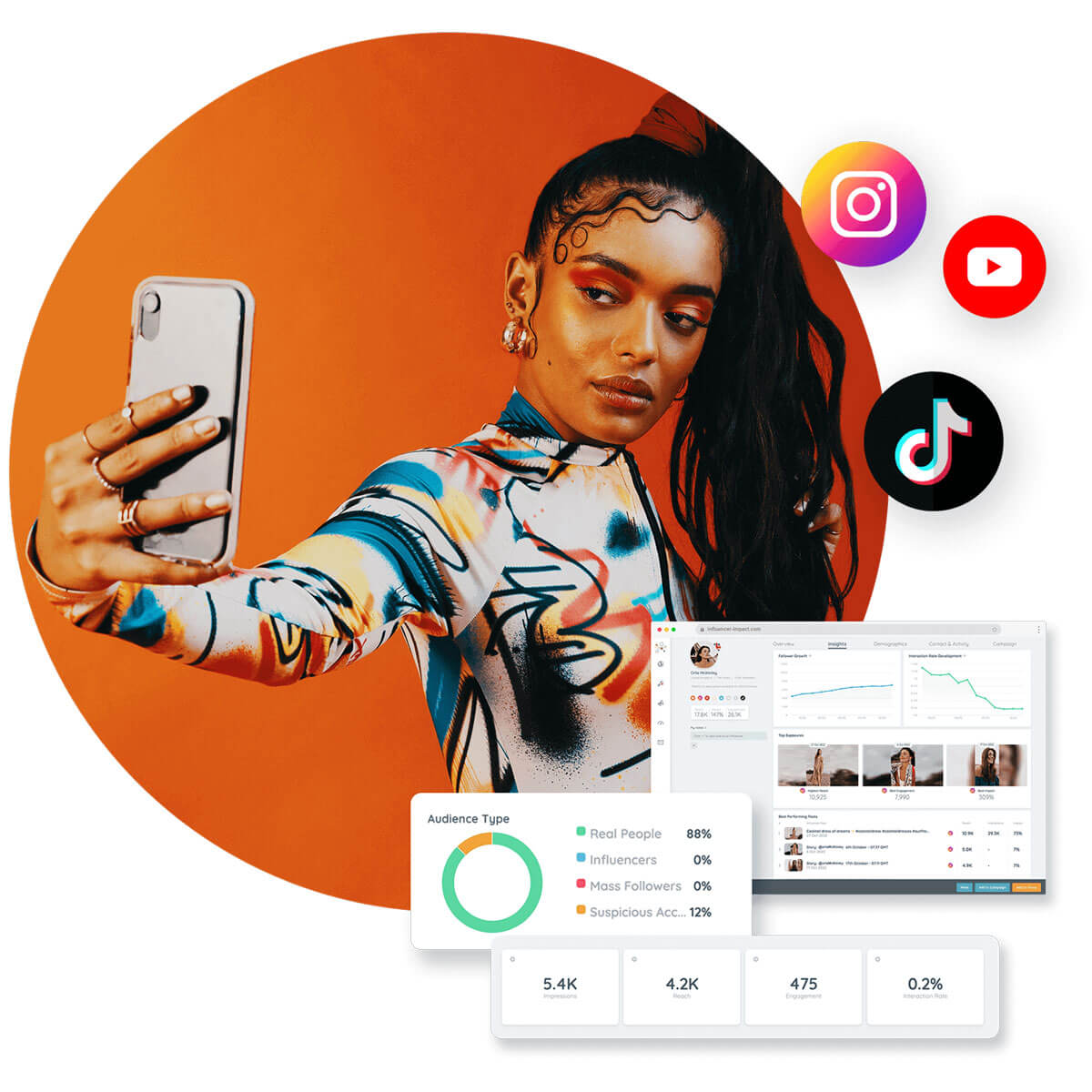
7. Track Performance and Optimize It:
Once the influencer campaign is live, track performance indicators such as engagement rates, clicks, and sales. Use this data to optimize the campaign for better results, and make adjustments as needed. 🤌 Here are some ways to track its performance:
-
Set clear goals and metrics: Before launching an influencer campaign, set clear goals and metrics for measuring its success. This will help you determine key performance indicators such as reach, engagement, and conversion rates.
-
Monitor social media mentions: Use social media monitoring tools to track mentions of your brand, products or services across social media platforms. This will help you identify influencers who are generating high engagement and reach.
-
Keep track of your social media analytics: Use social media analytics tools to monitor engagement rates, audience demographics, and other key metrics for your influencer campaign.
-
Use discount codes and custom links: Use custom discount codes or unique URLs to track conversion rates and sales generated by each influencer. 📣
-
Conduct surveys: Conduct surveys or polls to ask customers about their experience with the product or service promoted by the influencer.
-
Analyze ROI: Finally, use all the data you have collected to determine the ROI of your influencer campaign. Compare the cost of the campaign to your revenue generated to determine if it was a success. 💯
8. Measure the ROI:
At the end of the campaign, measure its ROI against the initial objectives. 🧨 Use this information to inform future influencer marketing campaign.
-
Track your metrics: Use tools to track the performance of your influencer campaign, such as engagement rates, clicks, impressions, and conversions.
-
Calculate your ROI: To calculate your ROI, subtract the total cost of the campaign (including influencer fees, content creation, and other expenses) from the revenue generated from the campaign. Then, divide the total by the campaign’s cost to get the ROI percentage. 💲
-
Analyze the data to see which influencer performed the best, which content types worked best, and which platform yielded the highest ROI. Use these insights to improve future campaigns.
How Marketing Influences Consumer Behavior?
Marketing influences consumer behavior in several ways: ⏬
-
Creating Awareness: Marketing helps to create awareness about a product or service among consumers. It highlights the features, benefits, and uses of the product, making it easier for consumers to understand and evaluate the offering. 🤔
-
Shaping Perceptions: Marketing helps to shape consumers’ perceptions of a product or service, influencing their beliefs and attitudes towards it. Positive perceptions can lead to increased interest and willingness to purchase.
-
Building Trust: Marketing helps to build trust between the brand and the consumer through consistent messaging, branding, and advertising. Trust plays a crucial role in purchase decisions, as consumers are more likely to buy from brands they trust. 🤗
-
Creating Desire: Marketing is able to create a sense of desire among consumers through targeted advertising and promotions. This can be done by highlighting the benefits or exclusive features of a product, or emphasizing the scarcity or limited availability of the offering.
-
Providing Convenience: Marketing also plays a role in providing convenience to the consumer. By using marketing techniques such as packaging, positioning and pricing, the product can be made more accessible and convenient to consumers. 🤑
💡 Overall, marketing has a significant impact on consumer behavior, influencing their purchasing decisions, attitudes, and perceptions towards a brand or offering.
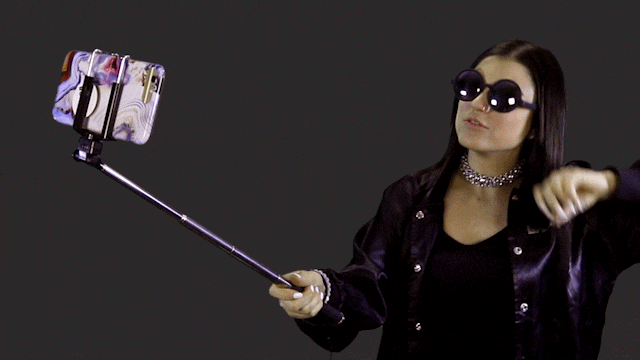
How Does Influencer Marketing Work?
Influencer marketing is a form of social media marketing that involves collaborating with social media influencers with a large following and engaged audience to promote a product, service, or brand to their followers. 🤩 Here’s how it works:
-
Find the right influencer: Identify influencers who have a significant following in your niche or industry, and whose audience matches your target demographic.
-
Set clear goals and objectives: Before beginning an influencer marketing campaign, set clear goals and objectives that align with your overall marketing strategy. 🌐
-
Collaborate: Work with the influencers to develop content that resonates with their audience and promotes your brand or product. The content can take many forms, including social media posts, blog posts, videos, or product reviews.
-
Amplify: Amplify the influencer’s content through paid advertising, social media, and other marketing channels to reach a wider audience.
-
Track and measure: Use analytics and tracking tools to measure the success of the campaign and evaluate the ROI. Adjust the strategy as necessary to optimize results. 🙌
💡 In summary, influencer marketing works by leveraging the social media reach of established influencers to increase brand awareness, build trust and credibility, and ultimately drive conversions and sales, by finding customers online! 💻
What is Influencer Marketing Examples?
As explained before, influencer marketing is a type of marketing that uses influential individuals or groups to promote a product or service to their respective audiences. ✨ Here are some examples:
-
Social media influencers: 🗣️ These include celebrities, bloggers, and YouTubers who have a large following on social media platforms such as Instagram, Facebook, and Twitter.
-
Brand ambassadors: 🪙 These are individuals who are hired by a brand to promote and endorse its products to their followers and fans.
-
Affiliate marketing: 🤝 This involves paying influencers a commission for every sale made through their unique affiliate link.
-
Sponsored content: 💰 This involves paying influencers to create content that promotes a brand or product.
-
Product reviews: 🧾 This involves sending products to influencers for them to use and review on their platforms.
-
Event sponsorship: 😉 This involves sponsoring events that are attended by influencers, in order to get exposure for a brand or product.
-
Influencer takeovers: 🫶 This involves allowing an influencer to take control of a brand’s social media account for a day, week, or longer, in order to create and share content promoting the brand or product.
Influencer Marketing Tools
Influencer marketing tool assists marketers in locating, interacting with, and negotiating deals with influencers, according to their specialty. 😏 Brands can employ influencer marketing tools to accomplish their objectives more quickly, rather than going about it the “traditional” way.
Additionally, some influencer marketing solutions provide insightful data about your campaigns, influencer relationships, and the most recent social media trends. 📊 When choosing the best course of action for upcoming prospecting campaigns, this information can be useful.
Therefore, here’s a list of 15 Influencer marketing tools: 🛠️
- BuzzSumo.
- Hootsuite.
- Traackr.
- Upfluence.
- Mention.
- Famebit.
- Klear.
- AspireIQ.
- Julius.
- NeoReach.
- Onalytica.
- CreatorIQ.
- Socialbakers.
- Grin.
- Spark Influencer Marketing.
👉 There’s no specific ranking for this list, the best way to go about it, is to test some of the tools for yourself, and see which ones work best for your specific needs!
Is it important to use influencer marketing tools?
Influencer marketing tools can help automate tasks , streamline processes, and use business intelligence to make your influencer campaigns more successful. 🤓
Benefits of influencer marketing tools include: 👇
- Connecting with the right influencers. Find the best influencers for your brand using AI search, filters and engagement analytics.
- Learning the latest on trends. Track trending hashtags, topics, music, issues and more to create relevant influencer and viral content.
- Making data-driven decisions. Use detailed analytics to track progress, analyze influencer success, and improve future campaigns.
- Analyzing your competition. Know what your competitors are doing and compare your own progress to create a better influencer marketing strategy.
Choose the best influencer marketing tools for your business
Choosing the right influencer marketing tool for your business can be confusing, especially when there are so many to choose from. Consider the following factors when deciding to invest in the right tool : ⏬
- User-friendly: Marketers are too busy to spend hours learning new software. Influencer marketing tools should make your job easier, not harder.
- Price: Choose influencer marketing software that fits your budget and has the features you need. For this reason, most tools offer multiple pricing plans, and you can always scale up .
- Features: Does your tool have all the features you need? How many filtering options does it offer to narrow your search for influencers? Do you provide analytics and reporting?
🤗 I hope that these tips are useful for your search of influencer marketing tools!
Influencer Marketing Statistics
Here are some expected statistics for this current year, according to the past trends: ⏬
-
Influencer marketing expenditure is predicted to reach $13.8 billion by 2023. (Influencer Marketing Hub)
-
Instagram will continue to be the primary platform for influencer marketing, with revenue expected to exceed $2 billion by 2023.
-
The micro-influencer trend will continue to grow, and brands will start to work with more authentic and niche influencers instead of major ones.
-
Video content will become even more dominant in influencer marketing, with TikTok expected to take a prominent position.
-
Gen Z consumers will become the most sought-after audience for influencer marketing, with brands expected to tailor their campaigns to this younger demographic.
However, we cannot predict the future, so you better stay on your toes to keep up with the new platforms, like the Metaverse for example! 🤖
Conclusion: What are the 4Ps of Influencer Marketing?
In conclusion, the marketing mix, commonly referred to as the 4Ps, is a crucial marketing concept. 💯 These 4P identify the 4 key components of a successful marketing plan:
- Product.
- Price.
- Place.
- Promotion.
👉 Furthermore, we’ve created a simple list of the many components of the 7 Ps and the 4 Ps in respect to influencer marketing:
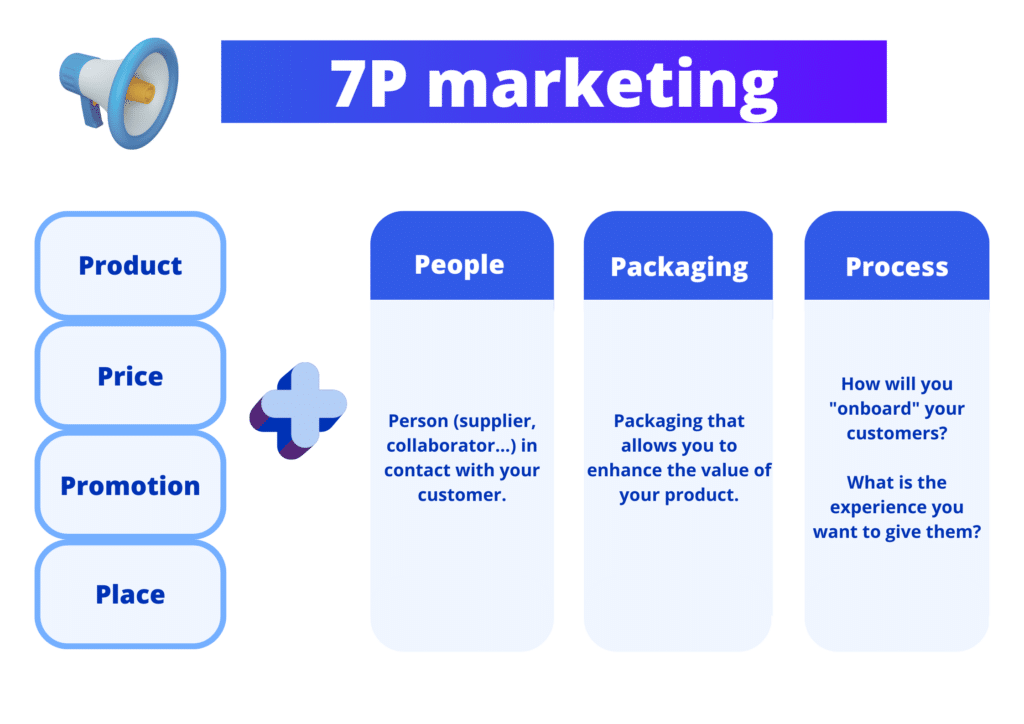
The 7 Ps of marketing are the 4 Ps, plus some: ⏬
- Product: Are your target market and product descriptions clear? Choosing the appropriate influencers to partner with will then be simpler for you.
- Price: Do you range from tens to hundreds of euros? Then using influencer marketing may be a wise move. Because consumers don’t have to ponder too much before making a purchase, businesses that sell FMCG (fast-moving consumer goods) benefit greatly from influencer marketing.
- Place: Do you offer FMCG products for sale to private clients online? Do you have a good use of influencer marketing? Do you not offer your products online, but rather through a select group of specialist retailers or distributors? In that case, influencer marketing might not be for you.
- Promotion: How do you wish to advertise your product? Influencer campaigns have emerged as one of the most effective strategies to advertise your product out of the numerous available options. Influencer marketing makes it considerably simpler and less expensive to reach your target demographic. Additionally, you may target all the relevant traffic that the influencers have created using other marketing channels like Facebook, Google, etc.
- People: How can you persuade more people to support your product? In order to boost your products and businesses, influencers can be a valuable external resource for your internal staff. When a corporation collaborates with an influencer to produce good content, they have a greater impact on their target audience than when they communicate with them directly.
- Processes: Is the consumer journey on your website optimal? Your online store must be well-designed, simple to use, and show what the customer is looking for. When you employ influencer marketing, the influencers are frequently adept at directing customers to the appropriate web page in your store, greatly easing their experience.
- Physical evidence: Do you provide your customers with any tangible proof? Utilize influencers as the tangible proof and ask them to demonstrate how to use your product for their audience.
Should Influencer Marketing be a part of your Marketing Mix?
After all, we’re all consumers here, so let’s do a little thought experiment together. 🧠 Think about your recent purchases or new parts of town you’ve explored. Do you remember how you first heard about these products and places? Did some of the information you used to make your decision come from family, friends, colleagues, acquaintances, or celebrities?
If so, consider yourself “influenced”! 👀
Word-of-mouth recommendations are nothing new. In fact, it’s not a bad thing…. When you use products and services, you have expressed your opinions and shared your experiences with the people around you.
“Influencer marketing” is the latest version of word- of- mouth, 😉 with selective enhancement of product placements from trusted sources (a.k.a. the Influencers). Many brands today use influencer marketing as a powerful reinforcing layer for their social network and content initiatives.
💡 The consumer world is busy. The customers’ attention gets often diverted, but they have also learned how to adapt and how to smell the bullshit miles away! 💩 So, with the flood of ads they see every day, it’s no wonder they trust people more than brands.
FAQ of the article
How is Influencer Marketing paid?
Influencer marketing can be paid in various ways, including: 🤑
-
Flat fee: This is a fixed amount that an influencer charges for creating and sharing content on their social media platforms.
-
Commission: Sometimes influencers are paid a commission based on the number of sales or leads generated from their content.
-
Free products or services: Instead of paying an influencer, brands may provide them with free products or services in exchange for their promotion.
-
Affiliate marketing: This is a performance-based model where influencers are given a unique referral code or link that they share with their audience. They earn a commission for every sale made using that code or link.
-
Hybrid model: This is a combination of one or more of the above payment methods, where influencers are paid a mix of flat fees, commissions, or free products or services.
Is Influencer Marketing difficult?
The short answer is yes, because there are thousands of influencers working with thousands of companies on each platform, the world of influencer marketing is complicated. Long-term relationships with social media influencers are challenging in the present environment. 😩
Because there are no clear rules, influencers frequently work with rival brands. If brand managers want to develop long-term cooperation with influencers, they must set clear expectations for them. 🧊
👉 The difficulties of influencer marketing can be solved with the correct study and application of influencer marketing technologies. Be sure to plan your campaigns by taking into account essential KPIs as well as outside variables like competition and user behavior. 🧐













